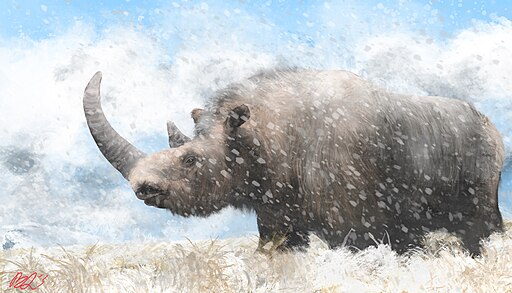Ice Age Giant of the Tundra
The woolly rhinoceros (Coelodonta antiquitatis) was a massive herbivorous mammal that roamed the Earth during the Pleistocene epoch, roughly 350,000 to 10,000 years ago.

| Meaning | Woolly nose horn [Woolly Rhino–ceros] |
| Pronunciation | WOO-lee ry-NOS-er-us |
| When: | Pleistocene (about 3.6 million to 10,000 years ago) |
| Where: | Europe, Asia (Northern Asia) |
| What: | Mammal (herbivorous) |
| Weight: | Estimated around 1,800–2,700 kg (4,000–6,000 pounds) |
| Length: | Approximately 3.5 meters (11.5 feet) |
| Diet: | Herbivorous (primarily grass and other vegetation) |
| Discovered: | First remains were found and described in the 18th century, but more formal scientific description occurred in the 19th century |
Known for its distinctive appearance, it had a thick, shaggy coat of fur, well-adapted to the cold climates of the Ice Age. Its most recognizable feature was the pair of long, curved horns on its snout, which could reach lengths of up to 1.5 meters (5 feet).
Woolly rhinoceroses were primarily grazers, feeding on grasses and other vegetation that grew in the tundra regions of northern Eurasia and North America.
They were well-suited to the harsh environments of the Ice Age, with their thick fur and layers of fat providing insulation against the cold.
Fossil evidence suggests that woolly rhinoceroses coexisted with early humans, who likely hunted them for their meat and fur.
The species eventually went extinct around the end of the last Ice Age, possibly due to a combination of climate change and hunting pressure from human populations.
